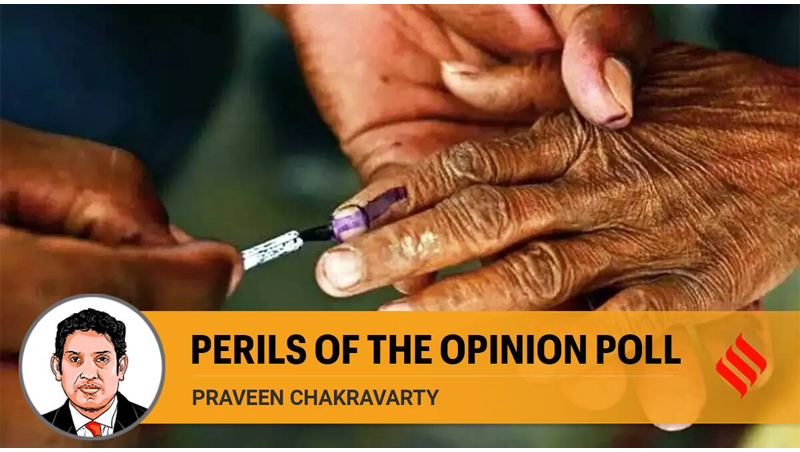Praveen Chakravarty writes: More often than not, they are used to influence voting behaviour, not reflect it
Praveen Chakravarty
November 9, 2021

65 per cent of Indian voters make their voting decisions quite late in an election. (File)
On October 9, the Chancellor of Austria, Sebastian Kurz, was forced to resign amidst a unique scandal. He was charged with orchestrating fake surveys and bribing the news media to show them as genuine opinion polls. It is common for political leaders to be caught in scandals but this is, perhaps, a first where the head of a nation had to resign for seemingly innocuous opinion polls. It is a reflection of the growing “weaponisation” of opinion polls in electoral democracies.
In the early days of election polling that began with the 1936 United States presidential elections, such surveys served merely as a pastime for the curious. Then, frequent polling evolved to act as a feedback loop for governments and politicians. However, in the last few years, political leaders and parties have weaponised opinion polling to shape and influence, rather than just reflect, public preferences.
Out of every 100 Indians who voted in the 2019 national elections, only 35 were committed voters, who were sure of which party to vote for even before the campaign began. The remaining 65 voters decided who to vote for in the last few days or weeks before election day (Lokniti National Election Study). So, 65 per cent of Indian voters make their voting decisions quite late in an election.
A rigged pre-poll survey disguised as an independent, scientific study by a professional survey agency and spread widely by a compliant and compromised media can play a powerful role in creating the hawa or a “wind of victory” for a particular party and influence the 30 per cent of floating voters to vote for that party. Since these polls carry a veneer of objectivity, voters are more easily misled. Thus, fake opinion polls can be extremely potent weapons in Indian elections.
To be sure, misleading opinion polls favouring one party do not always help, as witnessed in the recent Bengal state elections, when nearly every media outlet predicted BJP as a clear winner in their pre-polls while, in actuality, the BJP lost heavily.
But this does not change the fact that manipulated opinion polls propagated by a compromised media is a powerful weapon in Indian elections, deployed actively by some political parties. A rigged opinion poll disseminated widely with the potential to sway 30 per cent of the vote is as dangerous to India’s democracy as social media fake news, if not more.
There have been calls to ban pre-poll surveys in India by some scholars and political leaders, which may be an extreme step. However, the Election Commission can help voters detect fake opinion polls by setting some standards and guidelines.
Any opinion poll that does not reveal its survey methodology, sample selection technique, sample size and exact questionnaire should be considered suspect. A robust survey will also make its entire raw data public, for people to use and replicate the analysis. Most polls published by the Indian media, barring a tiny few, do not disclose even basic details of their survey methods, let alone publishing their data.
Most people judge a survey purely on their sample size with the assumption that a large sample size signifies a good survey. Pre-poll surveys for the 2020 US Presidential elections with 160 million voters had an average sample size of 3,000 people. The Reserve Bank of India determines interest rate decisions for a $3 trillion economy based on a survey of 6,000 out of the 250 million Indian families. Herd immunity levels of Covid was determined based on serological surveys of 30,000 people in Delhi for a population of 20 million.
The notion of a sample size is highly misunderstood. The selection of the sample is far more important than the size. To survey a state election in India, a robust sampling methodology should choose people from every assembly constituency, identity, age group and gender. A survey of a well-represented 2,000 people is far superior to a survey of 20,000 people chosen from just a few assembly constituencies or a specific religion or age group. As a rough thumb rule, a credible survey for a state election in a vastly diverse, multi-party, first-past-the-post democracy like India will need to survey 500-1,000 randomly chosen people from every assembly constituency, in order to predict seats with reasonable accuracy.
The Election Commission can mandate disclosure of detailed survey methods, raw data and prescribe minimum stratified sampling standards for pre-poll surveys. By these benchmarks, nearly every survey published by the Indian television media is suspect and dubious. A survey getting some elections right is not proof of its credibility or robustness, just as a broken clock is right twice a day. The broad field of empirical science, of which surveys are a small part, is an established discipline for which Nobel prizes have been awarded, not something that fly-by-night operators can replicate easily.
Opinion polls do not just reflect the opinions of people but influence them to create an aura of winnability. If 30 per cent of India’s voters are vulnerable to such influence, then there is a crying need to regulate this danger and protect the sanctity of India’s democracy.
This column first appeared in the print edition on November 8, 2021 under the title ‘Perils of the opinion polls’. Chakravarty is chairman of Data Analytics of the Congress party and a political economist
https://indianexpress.com/article/opinion/columns/problem-pre-poll-surveys-india-7611913/
